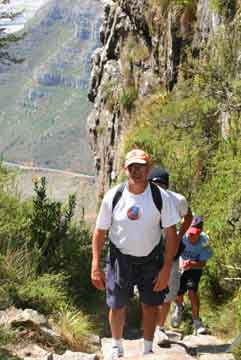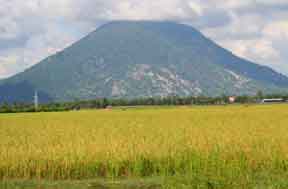Faculty Notes: You have to go to know |
| Printer-friendly version | Email this article |
|
Bert Barreto thought experiential learning was "sort of a joke." Would a trip around the world change his mind?
"I always thought experiential learning was sort of a joke."
But a trip around the world has softened his skepticism and opened his eyes to a mode of teaching that Barreto believes can be "a lot of fun, and very effective."
Barreto spent half his sabbatical last year teaching for Semester at Sea, a shipboard study-abroad program that circles the globe in 100 days—50 of those at sea and 50 in ports.
Barreto taught three economics courses on the ship, but it was the "off-campus" learning that captured his imagination. In each port, professors led students on a faculty-developed practicum (FDP), a field trip intended to enhance or demonstrate ideas discussed in class.
The school provides 20 pages of possible FDP’s, but Barreto designed his own.
"I tried to make them intellectual, and something real," Barreto says. "Some of my colleagues would choose one of the prepackaged FDPs. There was one where you’d go to the market, buy some cloth, and have it made into a dress.What kind of teaching is that?"
So Barreto created these FDPs:
➤ CLEAN UP THE WORLD IN BRAZIL
"We took 30 students to this isolated island off Brazil where trash washes from the cruise ships that illegally dump nearby. The island was the size of a mall and full of junk.We learned about the economics that drive this and other environmentally costly practices. And we cleaned it up. Being there was so much more powerful than anything I could have said in a lecture."
➤ MEDICAL TOURISM IN INDIA
"We went to the Apollo Hospital in Chenai, where Americans and Japanese fly in for heart surgery.You get a triple bypass from Western-trained doctors, but instead of costing $25,000, it costs $2,000.
"The first three floors are hot as hell and dirty. But when you reach the seventh floor, it’s like an American hospital—private rooms, computers, satellite TV. That’s where the Americans are.
"Students got to question the chief financial officer about the ethics of all this."
➤ JAPAN WITH THE JAPANESE
"Kotaro Yoshida ’95 helped us get together with students from Kobe University, and we took a tour together. Being with college students from the ‘home’ country really changed the dynamics and focus—it was fun, practical learning."
➤ PRICE FIVE GOODS IN EVERY PORT
"Each student in my introductory macroeconomics class priced five goods or services in each port, including gasoline and other necessities, as well as items rarely examined by economists—rum, candy bars, chips, and Neutrogena oil-free acne wash.
"They had to figure out which goods to price—not always easy given the diversity of ports we visited. We built a price index and talked about exchange rates, and at the end of the course, the students really knew about prices.
"Economics has a nasty reputation of being difficult and having a lot of numbers and tedious spreadsheets," Barreto told the Los Angeles Times. "But this was a discovery exercise. It was mysterious and it had an edge to it. Students were into that."
"You need outgoing, adventurous faculty to lead it—that sets the tone," Barreto says. "You also have to genuinely like and enjoy being with your students, because you’re with these kids 16 hours of the day. If you don’t, it really affects the trip. Some very respected economists would be horrible at this!
"Organization matters, too. If you just slap something together, the students pick up on that. But if you get the right faculty member, put the resources needed into it, and get the students to really buy in, experiential learning can be awesome," Barreto says.
The economist sums up his revised views with a quote from Compendium, Inc., CEO Kobi Yamada: "Some experiences simply do not translate.You have to go to know."
BERT’S BARGAINS
"Lots of economics books talk about widgets and fake stuff. What we have is a study of products that people really buy."
Bert Barreto’s Semester at Sea students priced 130 items in 10 ports around the world. Some fascinating finds:
➤ Vietnam was the least expensive when prices of goods and services were totaled. Japan was almost twice as expensive as Vietnam. An example: A small brewed coffee at a sit-down cafŽ was 31 cents in Vietnam versus $4.27 in Japan.
➤ A bottle of Corona costs $8 in India; $8 will buy 10 bottles of that same beer in Vietnam.
➤ A gallon of gas in Venezuela: 12 cents per gallon!
➤ A one-hour calling card costs 71 cents in Vietnam, whereas in Myanmar it was $43.20, Mauritius $22.67, South Africa $11.90, and Japan $16.95. The average was $14.77.
|

 BERT BARRETO is skeptical of experiential learning. "I think of myself as a no-nonsense teacher," the professor of economics says when asked why he hasn’t taken students on immersion trips or taught in the College’s study-abroad programs. "To become an economist, there’s material you need to study, so you just sit down and do the hard work.
BERT BARRETO is skeptical of experiential learning. "I think of myself as a no-nonsense teacher," the professor of economics says when asked why he hasn’t taken students on immersion trips or taught in the College’s study-abroad programs. "To become an economist, there’s material you need to study, so you just sit down and do the hard work. WITH SUCH EXPERIENCES behind him, Barreto can reflect on the criteria for a rich and effective immersion-learning trip.
WITH SUCH EXPERIENCES behind him, Barreto can reflect on the criteria for a rich and effective immersion-learning trip.